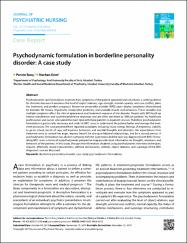Psychodynamic formulation in borderline personality disorder
| dc.contributor.author | Tunc, Pervin | |
| dc.contributor.author | Eren, Nurhan | |
| dc.date.accessioned | 2023-01-10T12:02:18Z | |
| dc.date.available | 2023-01-10T12:02:18Z | |
| dc.date.issued | 2020 | en_US |
| dc.identifier.citation | Tunç, P., & Eren, N. (2019). Psychodynamic formulation in borderline personality disorder: A case study. Journal of Psychiatric Nursing/Psikiyatri Hemsireleri Dernegi, 10(4). | en_US |
| dc.identifier.uri | https.//doi.org/10.14744/phd.2019.36002 | |
| dc.identifier.uri | https://hdl.handle.net/20.500.12294/3158 | |
| dc.description.abstract | Psychodynamic case formulation examines how symptoms of the patient appeared and constitutes a useful guideline for clinicians because it examines the level of object relations, ego strength, mental capacity, and core conflict, plans the treatment, and predicts prognosis. Borderline personality disorder (BPD) cases display symptoms characterized by dramatic life history, impulsivity, relationship problems, and unstable moods and behaviors. These unstable and multiple symptoms affect the clinical appearance and treatment response of the disorder. People with BPD build up intense transference and countertransference responses and are often perceived as “difficult patients” by healthcare professionals and nurses who spend the most time with these patients in inpatient services. Therefore, psychodynamic formulation is particularly necessary and useful in BPD cases to understand the patient better and manage the treatment processes. The case presented here reported complaints including mood swings, feelings of emptiness, inability to go to school, bursts of rage, self-injurious behaviors, and suicidal thoughts and attempts. Her expectations from treatment were to control her anger, express herself, be strong in bilateral relationships, and be a normal person. A psychodynamic formulation was done in company with the supervision and the case was diagnosed with BPD. Formulating BPD cases in terms of a psychodynamic perspective may provide more information on thoughts, emotions, and behaviors of the patients. In this study, through the information obtained using psychodynamic interview techniques, impulse, affectivity, mood characteristics, defense mechanisms, selfdom, object relations, and superego of the BPD diagnosed case are discussed. © 2019, Kare Publishing. All rights reserved. | en_US |
| dc.language.iso | eng | en_US |
| dc.publisher | KARE PUBL | en_US |
| dc.relation.ispartof | JOURNAL OF PSYCHIATRIC NURSING | en_US |
| dc.identifier.doi | 10.14744/phd.2019.36002 | en_US |
| dc.rights | info:eu-repo/semantics/openAccess | en_US |
| dc.subject | Borderline Personality Disorder | en_US |
| dc.subject | Case Study | en_US |
| dc.subject | Psychodynamic Formulation | en_US |
| dc.title | Psychodynamic formulation in borderline personality disorder | en_US |
| dc.title.alternative | A case study | en_US |
| dc.type | article | en_US |
| dc.department | Fen-Edebiyat Fakültesi, Psikoloji Bölümü | en_US |
| dc.authorid | 0000-0003-4938-0510 | en_US |
| dc.identifier.volume | 10 | en_US |
| dc.identifier.issue | 4 | en_US |
| dc.identifier.startpage | 309 | en_US |
| dc.identifier.endpage | 316 | en_US |
| dc.relation.publicationcategory | Makale - Uluslararası Hakemli Dergi - Kurum Öğretim Elemanı | en_US |
| dc.institutionauthor | Tunc, Pervin | |
| dc.authorwosid | GGF-0833-2022 | en_US |
| dc.authorscopusid | 56028187000 | en_US |
| dc.identifier.wosquality | Q4 | en_US |
| dc.identifier.wos | WOS:000511401800011 | en_US |
| dc.identifier.scopus | 2.0-85086167825 | en_US |
Bu öğenin dosyaları:
Bu öğe aşağıdaki koleksiyon(lar)da görünmektedir.
-
Psikoloji Bölümü Makale Koleksiyonu [120]
Psikoloji Bölümüne ait makaleler bu koleksiyonda listelenir. -
TR-Dizin İndeksli Yayınlar Koleksiyonu [573]
TR Dizin Indexed Publications Collection -
WoS İndeksli Yayınlar Koleksiyonu [1334]
WoS Indexed Publications Collection


















